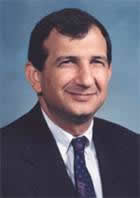Hazim J. Safi, M.B., Ch.B.
Surgery

Advances in brain and spinal cord protection in aortic surgery
Dr. Safi received the award for developing innovative techniques for cerebral and
spinal cord protection during thoracic aortic surgery and then rigorously proved
their therapeutic benefit. Although methods to maintain blood supply to the brain
and spinal cord have greatly improved, ischemic insults to the brain and spinal
cord have long plagued aortic surgery. Profound hypothermia and circulatory arrest
were a great leap forward and ascending and arch surgery became commonplace. However,
utilizing profound hypothermic circulatory arrest at greater than 40 minutes cross-clamp
increases the incidence of stroke; cross-clamp times greater than 65 minutes are
associated with an increase in death. Dr. Safi tested retrograde cerebral perfusion
and demonstrated its efficacy in a porcine model. Subsequently, using this technique,
he showed a reduction in the incidence of stroke in a clinical trial. Current plans
are underway for a randomized trial comparing retrograde and antegrade cerebral
perfusion in surgery of the ascending and transverse arch. Since the inception of
surgical repair of thoracoabdominal aortic aneurysm under cardiopulmonary bypass
and passive shunt through the 1970’s, neurologic deficit for this procedure was
relatively high. Although utilization of individuals adjuncts met with limited success,
synergistic use of CSF drainage and distal aortic perfusion has virtually eliminated
paraplegia in Type I and DTAA and markedly reduced neurologic morbidity in Type
II TAAA.
Dr. Safi’s nomination was based on the following publications:
Safi HJ, Letsou GV, Iliopoulos DC, Subramaniam MH, Miller CC 3rd, Hassoun H, Asimacopoulos
PJ, Baldwin JC."
Impact of retrograde cerebral perfusion on ascending aortic and arch aneurysm repair.
". Ann Thorac Surg. 1997 Jun;63(6):1601-7.
Safi HJ, Campbell MP, Miller CC 3rd, Iliopoulos DC, Khoynezhad A, Letsou GV, Asimacopoulos
PJ. "
Cerebral spinal fluid drainage and distal aortic perfusion decrease the incidence
of neurological deficit: the results of 343 descending and thoracoabdominal aortic
aneurysm repairs.". Eur J Vasc Endovasc Surg. 1997 Aug;14(2):118-24.